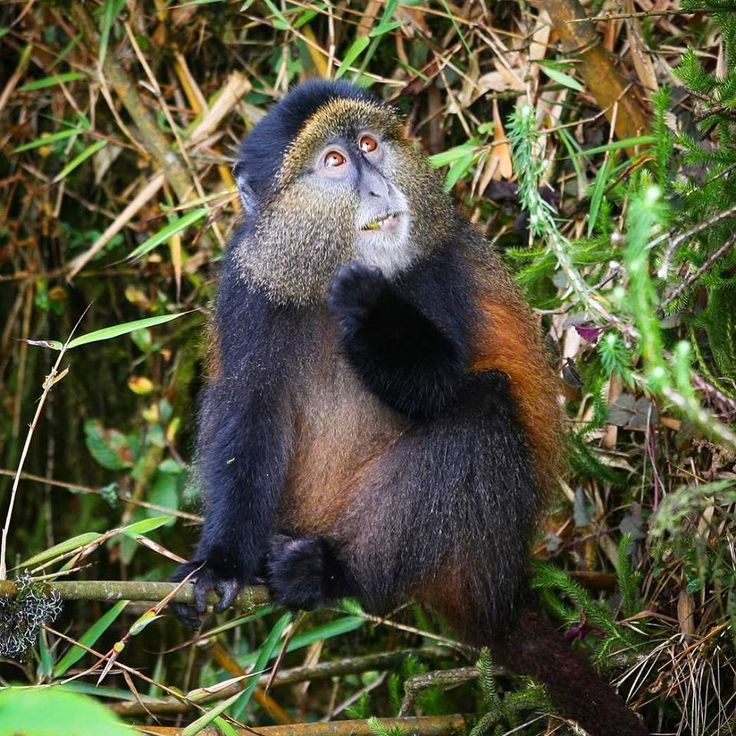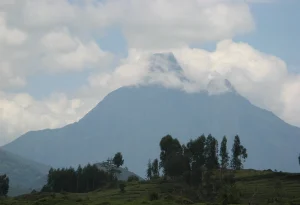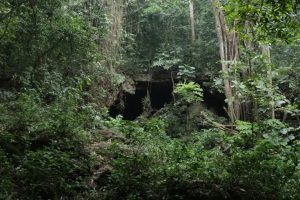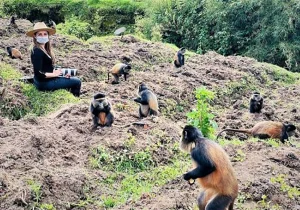Golden monkey trekking has become one of the most fascinating wildlife experiences in East Africa. These vibrant, playful primates are endemic to the Virunga Volcanoes region, where they thrive in the dense bamboo forests of Volcanoes National Park (Rwanda), Mgahinga Gorilla National Park (Uganda), and Virunga National Park (Democratic Republic of Congo). But many travelers ask: “How hard is it to see golden monkeys in the wild?”
This comprehensive guide answers that question with clarity and authority focusing on accessibility, physical demands, timing, and location so you can plan your trip with confidence. Whether you’re including golden monkey tracking as part of a gorilla trekking adventure or seeking a stand-alone primate tour, this article ensures you’re fully prepared.
Are Golden Monkeys Hard to Spot in the Wild?
No, golden monkeys are not hard to see—they are among the easiest primates to track in East Africa. These monkeys live in large, noisy troops (sometimes over 80 to 100 individuals), and their territories are well known to park rangers and local guides. Unlike mountain gorillas that are elusive and move more unpredictably, golden monkeys tend to stay within defined areas of high-altitude bamboo forests and are highly active during the day.
Their social and curious nature also means they rarely shy away from human presence, especially when habituated. This makes sightings highly reliable visitors frequently spot them within an hour of trekking.
What Is the Trekking Experience Like?
While golden monkey trekking is generally considered moderate to easy, it’s still a wilderness experience that requires basic physical fitness. The trekking path takes you through lush, hilly bamboo forests at elevations between 2,200 to 3,000 meters (7,200–9,800 feet) above sea level. Here’s what to expect:
- Trek Duration: Typically between 1 and 3 hours round trip, depending on where the monkeys are located that day.
- Terrain: Mostly gentle slopes, but some areas can be muddy, especially in the rainy season.
- Altitude Consideration: While the trails aren’t overly steep, high altitude may make breathing a bit more challenging for some travelers.
Despite these minor challenges, golden monkey trekking is generally suitable for families, seniors, and travelers who may not be fit enough for gorilla trekking.
What Is the Best Time to See Golden Monkeys?
Golden monkey tracking is available year-round, but conditions vary depending on the season:
- Dry Season (Best time):
- June to September
- December to February
These months offer better trail conditions, clear skies, and easier mobility.
- Wet Season:
- March to May
- October to November
While sightings are still frequent, trails may become slippery and harder to navigate.
Travel Tip: Dry seasons align with peak gorilla trekking windows, making it ideal for combining both primate experiences in one trip.
Where Can You See Golden Monkeys?
Golden monkeys inhabit only a small portion of the world—the Virunga Mountains—and are classified as endangered due to habitat loss. Your best chances of seeing them are in:
- Volcanoes National Park, Rwanda
This park is the most popular destination for golden monkey trekking. Tours start from Kinigi, the park headquarters. Rwanda offers exceptionally organized and well-managed treks, with a good success rate of sightings. - Mgahinga Gorilla National Park, Uganda
Mgahinga offers both regular golden monkey treks and a special Golden Monkey Habituation Experience, where visitors spend more time (up to 4 hours) observing the monkeys as they adjust to human presence. - Virunga National Park, DRC
Though less visited due to occasional instability in the region, Virunga also houses these primates. However, logistics and safety considerations make Rwanda and Uganda more accessible for international tourists.
How Much Does Golden Monkey Trekking Cost?
Compared to gorilla permits, golden monkey permits are far more affordable:
- Rwanda:
Golden monkey permit = USD $100 per person - Uganda:
- Regular permit = USD $100
- Habituation experience = USD $150
Permits include entrance to the national park and ranger guides. It’s advisable to book in advance, especially during high season, to secure your spot.
How Close Can You Get to Golden Monkeys?
Visitors usually spend 1 full hour observing the golden monkeys once located. Because the monkeys are habituated, they may come as close as a few meters, allowing for incredible views and photos. However, photography can be tricky due to their quick movements and forest cover. Bring a camera with a fast shutter speed and good zoom.
Is a Guide Required for Golden Monkey Trekking?
Yes. All treks are guided by trained park rangers who track the monkey troops daily. Guides help:
- Navigate the forest terrain
- Ensure visitor safety
- Interpret golden monkey behavior
- Enforce ethical wildlife viewing practices
Their presence ensures not only safety but a richer, more educational experience.
What Makes Golden Monkey Trekking Special?
Golden monkey trekking is one of the few experiences that offer a high success rate, low physical demand, and a deep connection to wildlife. Here’s why it’s unique:
- Species Rarity: Golden monkeys are only found in this region.
- Behavior: Their playful, energetic nature is engaging to watch.
- Group Dynamics: Trekking in small visitor groups (usually 8 people) allows for a more personal and immersive experience.
- Add-on Option: Easily combined with gorilla trekking, volcano hiking, or cultural experiences like Batwa village visits.
How Should You Prepare for a Golden Monkey Trek?
Here’s a simple checklist for what to wear and bring:
- Sturdy hiking boots
- Rain jacket or poncho
- Long trousers and sleeves to protect against insects and brush
- Insect repellent
- Daypack with water and snacks
- Camera with fast shutter and zoom lens
- Walking stick (often provided at the park gate)
Can Children Participate in Golden Monkey Trekking?
Yes. Unlike gorilla trekking (minimum age 15), golden monkey trekking allows children as young as 12, depending on park regulations and the child’s fitness level. This makes it an excellent family-friendly wildlife activity.
Can You Combine Golden Monkey Trekking with Other Activities?
Absolutely. Most travelers incorporate golden monkey trekking as part of a broader East African adventure, which may include:
- Mountain gorilla trekking in Bwindi or Volcanoes
- Hiking Mt. Bisoke or Mt. Muhabura
- Lake Bunyonyi canoeing or relaxation
- Cultural village experiences
- Big five safaris in Queen Elizabeth or Akagera National Parks
With most golden monkey treks starting and ending in the morning, you can easily plan additional excursions the same day or the following.
Is It Hard to See Golden Monkeys?
Seeing golden monkeys is not hard—in fact, it’s one of the most accessible wildlife experiences in Africa. Their high population density in protected parks, large social groups, and energetic behavior make sightings highly likely and incredibly rewarding.
Whether you’re a seasoned safari-goer or a first-time visitor to East Africa, golden monkey trekking offers a low-strain, high-impact encounter with a critically endangered species. For photographers, nature lovers, and families alike, it’s a magical experience that complements the grandeur of gorilla trekking while offering a lighter, yet equally immersive, adventure.
By choosing the right season, securing your permit early, and preparing for forest trekking, you set yourself up for an unforgettable wildlife moment—face to face with the golden monkeys of the Virunga Mountains.




